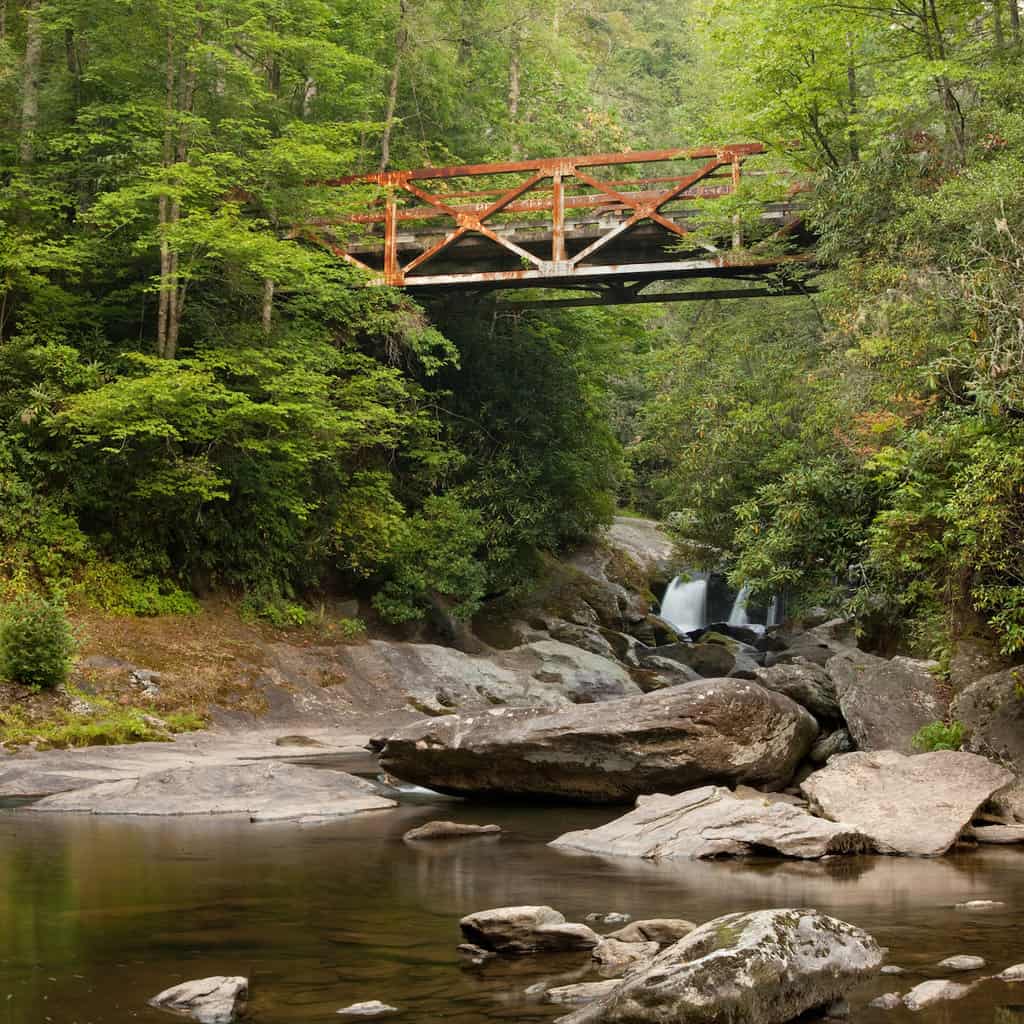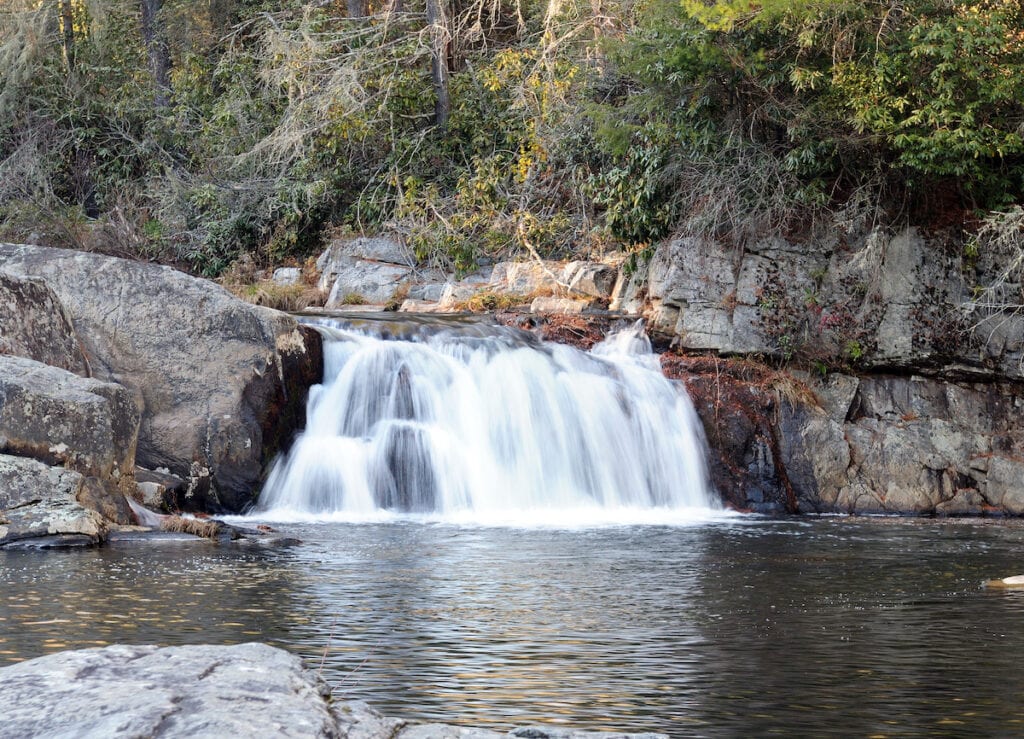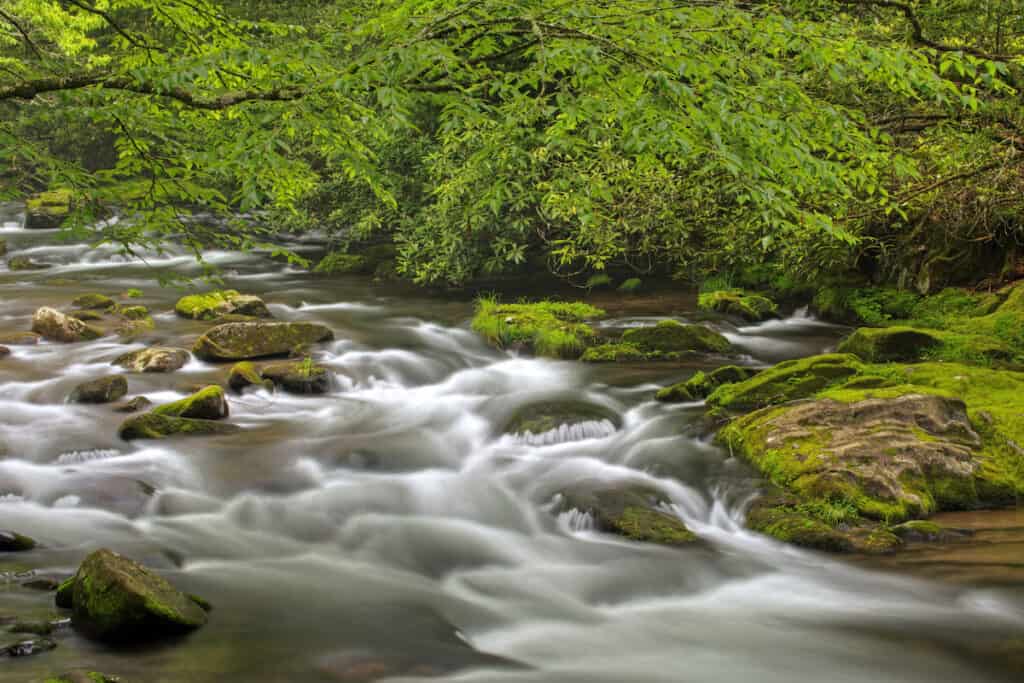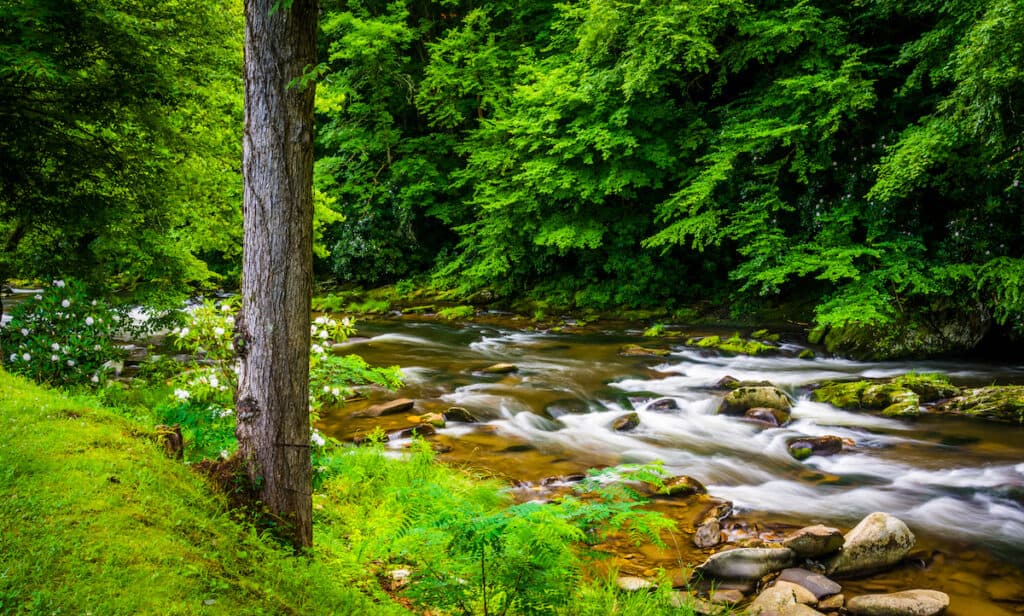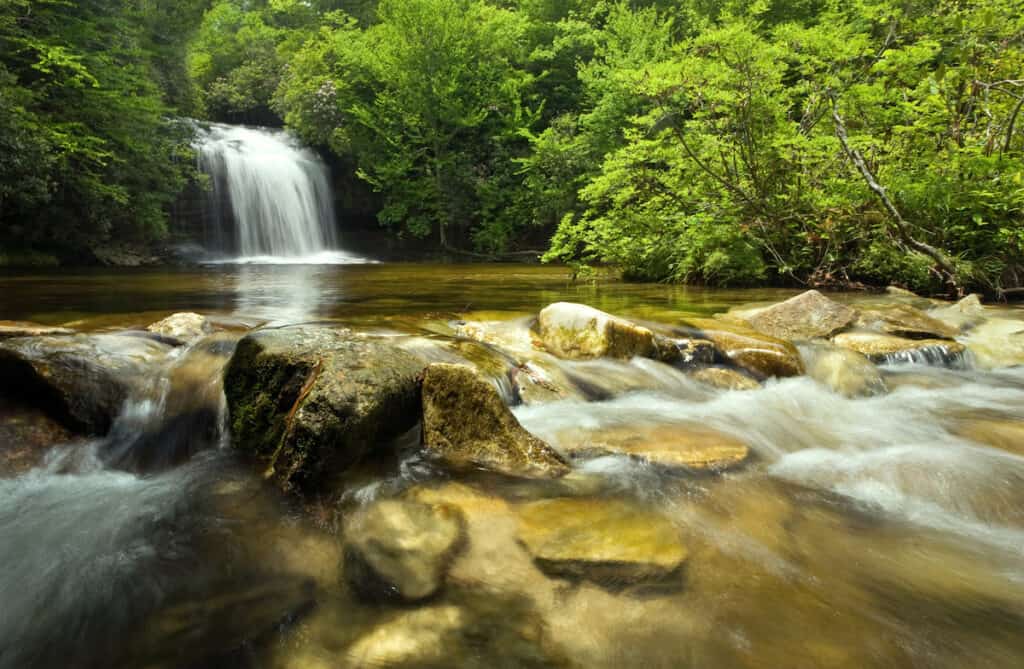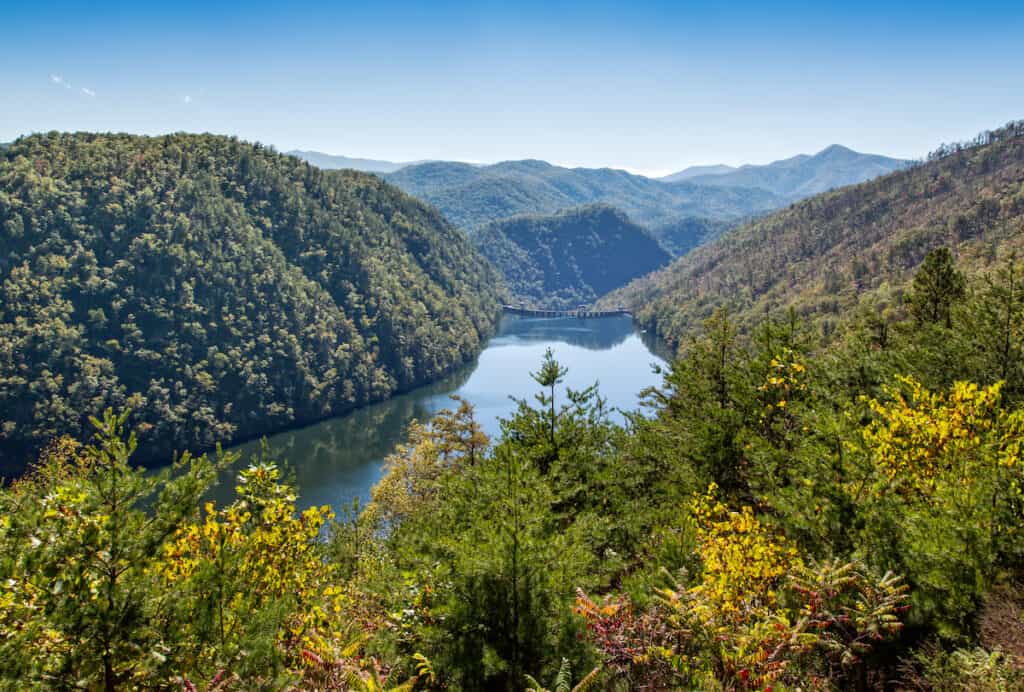If your idea of a dream fly fishing trip involves casting for wild trout in a mountain stream, knee-deep in chilly water, surrounded by a jumble of boulders beneath a thick canopy of trees, the place you envision might be in North Carolina.
Almost all of North Carolina’s best trout waters are in the mountainous western part of the state, where rivers and streams remain cool enough for trout to live comfortably year-round. Several lakes in this region also offer excellent trout fishing.
The only trout native to South Carolina is the Southern Appalachian strain brook trout, a prized catch in many small, cool mountain streams, especially in the Great Smoky Mountains.
Northern brook trout have also been widely stocked throughout the state, and the two species are virtually indistinguishable.
The North Carolina Wildlife Resources Commission also stocks rainbow trout and brown trout in numerous hatchery-supported waters, and wild populations of both have also become widely established.
Though hundreds of rivers and streams provide excellent trout fishing in North Carolina, many of them much farther off the beaten path than those listed below. What follows are the best of the best.
Davidson River
The Davidson River meanders through the wooded mountains of Pisgah National Forest, about 45 minutes southwest of Asheville. It’s a beautiful freestone stream typical of the Southeast, with long runs and riffles that tumble into clear pools.
Anglers can find wild brook trout near the headwaters, while wild browns and rainbows primarily populate the river’s midsection.
The Davidson River is managed as a wild trout water down to the confluence with Avery Creek. Anglers must use only single-hooked artificial lures in this reach.
Below Avery Creek, the Davidson River is hatchery-supported, with no bait or lure restrictions and a 7-fish daily creel limit. In fact, the mile from Avery Creek to the Forest Service boundary is one of the most heavily-stocked river sections in the state.
Ultimately, the Davidson is one of the best fly fishing rivers in North Carolina, but don’t make the mistake of thinking that fishing here is easy. Its proximity to Asheville translates to very high pressure.
The trout in the wild sections of the Davidson River are no dummies. They’ve seen all manner of flies, and you won’t tempt many of them by dangling a Stimulator over their heads.
Dry fly fishing, in general, can be challenging here because, realistically, nothing in particular is hatching most days. And when there is a hatch going, you’ll need to match it well to tempt these wary trout.
Otherwise, nymphing is a better bet.
The Davidson River hosts one of the better Green Drake hatches in the Southeast, and anglers can take advantage of this very popular hatch for a couple of weeks in May.
Blue Winged Olives are more consistent. Various near-identical species that go by that name hatch at different times from February to October.
Green Sedges hatch from May to early June, and nymphs that mimic their larvae can be effective throughout the year.
Great Autumn Brown Sedges are available in fall, arguably the best time to fish the river, especially for larger brown trout.
Trophy browns in the Davidson seldom strike insect imitations at all, instead feeding on heftier fare like minnows, sculpins and crayfish. Cater your flies (or lures and bait where legal) to those more filling menu items.
River access is available at numerous pull-offs along US-276 (Pisgah Highway) and Forest Service Rd. 475.
Linville River
Famous for being one of North Carolina’s most beautiful rivers, the Linville River is also an outstanding trout stream that offers wild brook, brown and rainbow trout as well as hatchery-raised individuals of all three species.
Most of the river flows through the Linville Gorge Wilderness within Pisgah National Forest, and access is abundant, though not always easy.
This river also changes quite a bit from its headwaters to its lower reaches.
Unlike many North Carolina rivers, the Linville is fairly slow and low-gradient near its headwaters. Rather than rushing and tumbling down through the mountains, it meanders and takes its time.
That makes the upper Linville River a truly enjoyable place to fish, and despite its slow pace, the water is plenty cool and well-oxygenated to keep trout happy.
Easy access is available just off the Blue Ridge Parkway and along Linville Falls Road.
The falls is where the river changes. Beginning at Linville Falls, the river enters the steep, rugged Linville Gorge, where it rapidly descends 1,800 feet in the span of a few miles.
The walls of the gorge are steep, and the river is turbulent as it plunges between them, but this stretch is a truly stunning place to fish. There are also some monster brown trout lurking in the deep plunge pools throughout the Linville Gorge.
A hiking trail parallels the river through the gorge for about 15 miles. Fishing in this section can be very rewarding, but it’s also difficult and can also be quite dangerous. Hike with a partner and plan extra time to climb back out.
Farther down, the Linville River is dammed to form Lake James, and another excellent trout fishery exists in the tailwater below the dam. The tailwater is heavily stocked and broad enough to accommodate drift boats and a state-operated bank fishing site.
Nantahala River
More famous for its whitewater than its fly fishing, the Nantahala River is also a spectacular trout fishing water. Various opportunities are available in different sections of this river, which begins on the slopes of Standing Indian Mountain in Nantahala National Forest.
The upper Nantahala River is wild trout water and is the most seldom-fished section due to its remoteness. But for anyone looking for an off-the-beaten-path adventure, it can be great fun to chase wild rainbows and brook trout here. National Forest roads and trails offer ample access.
Usually, when you hear talk of trout fishing in the Nantahala River, it’s in reference to the portion below Lake Nantahala. This stretch can itself be broken into two very different sections.
The river here is unique because water is piped from the dam to the Nantahala Powerhouse, about 7 miles downriver at the head of the Nantahala Gorge. The stretch from the dam to the powerhouse is fed solely by small tributaries.
Often little or no water flows right below the dam, but the river grows gradually as more and more creeks feed it.
The section from White Oak Creek to the Powerhouse is perhaps the best stretch to wade and has excellent fishing for stocked browns and rainbows.
There are some serious trout in this section, which is managed under delayed harvest regulations. The state record brown trout, weighing 24 pounds, 10 ounces, was caught here.
Starting at the Powerhouse, the river balloons in size. This section is the launch point for most whitewater rafting trips on the river, and it can be quite challenging.
Wading is only possible on days when water is not discharged, so check the release schedule before you go.
Blue Quills and Quill Gordons are consistent hatches from February through March, and Little Black Caddis hatch prolifically in mid-February.
Numerous mayfly species hatch in spring, of which the Light Cahill hatch in late April and early May is the most reliable.
South Mills River
A tributary of the French Broad River not far from Asheville, the South Mills River is one of the best wild trout rivers in North Carolina. It’s also a charmingly scenic river that winds through wooded hills beneath a canopy of mountain laurel and mixed evergreens.
A small to midsize river, the South Mills is home to wild populations of brook, brown and rainbow trout. The state regulates it as a wild trout water, with no closed season. Anglers must use only artificial lures with a single hook may, and a daily creel of four fish is in place.
The South Mills River has a moderate gradient, with numerous short runs and brief plunges into deep pools.
Those pools are where you’ll find some of the larger brown trout. True trophies are rare, but 20-inch browns are around.
Rainbows are more commonly caught in the runs and plunges. Brookies are most common way up at the headwaters and in the many feeder creeks that empty into the South Mills River.
Like many North Carolina rivers, the best fishing takes place in spring and fall. However, its high elevation and numerous plunges keep the South Mills River cool and well-oxygenated even in the hottest part of summer.
About 12 miles of the South Mills River flow through Pisgah National Forest, and the South Mills River Trail provides hiking access to this entire stretch. The trail is popular for mountain biking and horseback riding as well, so plan on walking or wading off-trail to get away from high-traffic spots.
Numerous insects hatch here, but few do so consistently or in great numbers. Come prepared with flies that mimic all the classic Western North Carolina hatches.
Nymphing is usually effective, and catch-alls like Attractor flies can work, though they seldom fool the older, larger trout.
North & South Toe River
The Toe River system provides a variety of trout fishing opportunities in Mitchell and Yancey Counties.
Excellent fly fishing is available in both the South Toe River and the North Toe River, which meet to form the river’s brief main stem, itself a tributary of the Nolichucky River.
The South Toe is the more highly regarded for fly fishing. The smaller, wilder and less developed of the two rivers, it is mostly designated as wild trout water. Wild brown and rainbow trout can be caught here, along with native Southern Appalachian brook trout.
The upper section is quite rugged, but South Toe River Road follows the river and provides ample opportunities to hike in. It’s very intimate water, with small plunges and pools and little casting room.
Expect to see few other anglers in the wild trout water at the upper end of the river.
As the South Toe opens up below the confluence with Clear Creek, it becomes more accessible and more popular. The lowest 10 miles are hatchery-supported. Use Halls Chapel Road to reach much of this lower section.
If you enjoy pursuing wild trout, don’t ignore the South Toe’s tributaries. Smaller streams like Upper Creek and Lower Creek have their own designated wild trout waters.
The North Toe River is also an excellent trout river, especially in its upper reaches. The delayed harvest section around Spruce Pine is especially good, with ample access and regular stocking.
Expect mostly brown trout in this section, with some rainbows and occasional brookies.
Anglers catch browns over 24 inches here, and smallmouth bass are also common in the North Toe.
Brown Caddis and Giant Black Stoneflies are good spring hatches, and summer anglers often connect using Hendricksons and terrestrials.
Oconaluftee River
There are numerous excellent trout streams in the Great Smoky Mountains National Park. But whereas many are small and difficult to access, the Oconaluftee River is one of the largest and easiest to fish.
About 18 miles long, the Oconaluftee River forms with the confluence of the Beech Flats Prong and Kephart Prong. From there, it runs generally southward, paralleled by Newfound Gap Road (US 441), which includes numerous pull-offs and trailheads for access.
Brook, brown and rainbow trout are all available.
The Oconaluftee has a low to moderate gradient—just enough to keep it cool and oxygenated—and an abundance of boulders and pocket water. It’s a classic trout stream with typical pool-run-riffle configurations.
One thing to be aware of here is that the Oconaluftee is a very different river above and below its largest tributary, the Bradley Fork (a solid trout stream in its own right).
Above the Bradley Fork, the Oconaluftee is a tiny river, closely hemmed in by foliage.
Native Southern Appalachian brook trout inhabit the upper end, and the competition from other anglers is minimal, but making a good cast can be a challenge. Short rods are ideal, and some creative maneuvering may be required.
Below the Bradley Fork, the river opens up and becomes vastly easier to fish. Large brown trout become more common, along with some very aggressive rainbows.
Hopper flies can be quite effective in summer and fall in parts of the lower river bordered by open, grassy fields.
The Oconaluftee River has some of the most prolific hatches in the Smokies. A lot of typical Western NC hatches happen here, with the abundant Little Yellow Stonefly hatch in May being one of the most noteworthy.
Watauga River
A little over 78 miles long, the Watauga River originates at the base of Grandfather Mountain before crossing the NC/TN state line and emptying into the South Fork Holston River. Along the way, the river provides opportunities to target all three major trout species.
The best-known section for trout fishing is the Watauga Tailwater, which lies below Wilbur Dam in Tennessee. But the Upper Watauga River in North Carolina also offers excellent trout fishing.
The tricky part is access, especially near the headwaters. The Watauga River has wild trout regulations down to the SR 1580 bridge, but this stretch flows almost entirely through private land. The best option here is to lodge or camp on the river or contact a local guide.
Continuing downriver, the Watauga grows from a small to a mid-sized river, and access improves.
Below SR 1580, the river is under delayed harvest regulations, and there is excellent access along Old Shulls Mill Road for about a mile.
This stretch is strewn with large boulders, which provide ideal current breaks for trout. Some very nice brown trout are available in this area, as well as rainbows and brook trout.
The delayed harvest section is ideal for beginner fly anglers because it’s wide enough and open enough overhead to allow easy casting.
The trout, a mix of wild and hatchery-raised fish, are not quite as wary as elsewhere, though catching a trophy is challenging.
Insect hatches are varied and abundant.
Blue Winged Olives appear from February to June and again in October and November.
Several stonefly species produce successive hatches in winter through spring, starting with Little Black Winter Stoneflies in January.
Spring mayfly hatches include Blue Quills, Quill Gordons, Hendricksons, March Browns and Eastern Pale Evening Duns.
More: Complete Guide to Fishing the Watauga River
Western North Carolina Fly Fishing Trail
The Western North Carolina Fly Fishing Trail is a collection of rivers and streams flowing through Jackson County in the state’s southwestern corner. Primarily centered around the Tuckasegee River and its tributaries, the trail offers exceptional trout fishing.
That includes opportunities to target brook, brown and rainbow trout in 4,600 total miles of streams, 1,100 miles of which are hatchery-supported waters. North Carolina stocks around 100,000 trout here every year, but many areas also offer exclusively wild fish.
It can also be an overwhelming amount of water to wrap one’s head around, but the following are some of the best spots, including sections ideal for beginners and some more advanced fly fishing areas.
Tuckasegee River
The Tuckasegee River forms the core of the Western North Carolina Fly Fishing Trail. The river has abundant trout, wide banks, and numerous access points, making it a beginner-friendly fly-fishing river.
Often referred to as “the Tuck,” the Tuckasegee is stocked with brook trout, brown trout and rainbow trout. Five river sections are managed as hatchery-supported water, totaling about 20 miles.
The stretch from the NC 107 bridge through Dillsboro is one of the best overall sections of the river, and a wide range of methods can be effective on these hatchery-raised fish.
The major hatches in this reach are mostly Blue Winged Olives and caddisflies, including Cinnamon Caddis.
In addition to the main stem, there is also excellent fishing in the Tuckasegee’s East and West Forks.
Both forks are dammed for hydroelectric power before they merge, and the lower sections of each branch offer outstanding tailwater fisheries thanks to cold water from their respective dams.
Raven Fork
One of the most highly regarded waters in the Western North Carolina Fly Fishing Trail, the Raven Fork is known for both numbers and size.
This stream is one of the better spots in North Carolina to tangle with a trophy trout over 24 inches.
A 2.2-mile section starting at the Blue Ridge Parkway is managed as a catch-and-release, fly-fishing-only stream. It’s stocked with brook, brown rainbow, Donaldson, and golden trout.
This part of Raven Fork is on Cherokee land, and an Eastern Band of Cherokee Indians Tribal Enterprise Fishing Permit is required to fish here.
Much farther upstream, another section of the Raven Fork is managed as wild trout water within the bounds of Great Smoky Mountain National Park. It’s much more difficult to reach, but well worth the effort.
Scott Creek
Scott Creek is easily accessible and amply stocked, making it an all-around great choice for fly fishers of any experience level.
All 10 miles of the creek, from its headwaters to its confluence with the Tuckasegee River near Sylvia, are hatchery-supported.
Brown trout and rainbows are stocked in Scott Creek, and although fishing for both is excellent from October through April, Scott Creek is better known for numbers than for size.
Numerous pull-offs along US-23 and other local roads provide ample access.
Savannah Creek
Similar to Scott Creek, Savannah Creek is a hatchery-supported trout stream of approximately 10 miles in length that is noted more for numbers than size.
Rainbow and brown trout are abundant in this creek, and anglers can typically catch them using a wide variety of methods.
There’s excellent fishing from Savannah Creek’s headwaters in Pumpkintown all the way to its confluence with the Tuckasegee River, though access is more plentiful on the creek’s upper half. Numerous pull-offs are along US-23/441.
Greens Creek
A small tributary that empties into Savannah Creek, Greens Creek is ideal for anyone looking for intimate fly fishing on a small stream.
Between 2 and 3 miles of Greens Creek are managed as a combination of hatchery-supported and wild trout water.
Look for access at various pull-offs along SR 1370, also known as Greens Creek Road. Much of the land along the stream is privately owned, so take care to avoid trespassing.
Expect to catch mostly rainbow trout with the occasional brown mixed in.
Caney Fork
Caney Fork Creek is a mid-sized stream that feeds the Tuckasegee River near East Laport.
Mostly shallow with some excellent waist-deep pools, the Caney Fork offers a mix of wild and hatchery-raised trout. Brooks, rainbows and browns are all available, including some very large fish.
Anglers will find access along SR 1737 (Caney Fork Road).
However, quite a bit of the Caney Fork flows through private property, so keep an eye out for posted signs. Some local fly fishing guides offer access to otherwise off-limits sections of the stream.
Several smaller tributaries of the Caney Fork also offer excellent fishing for wild brook and rainbow trout. These include Moses, Mull, Rough Butt, Chastine and Piney Mountain creeks.
Panthertown Creek
Panthertown Creek packs a lot of great fishing into its brief 3-mile length. Managed exclusively as a catch-and-release, single-hook artificial lure-only stream, Panthertown Creek is one of the best spots on the Western North Carolina Fly Fishing Trail to target wild brook trout.
Accessible only on foot, the best way to get to Panthertown Creek is from the hiking trail that begins at the end of Breedlove Road (SR 1121).
The creek flows through the rugged Panthertown Valley, dubbed the “Yosemite of the East.”
Tanasee Creek
Wild brown trout are the most commonly caught species in Tanasee Creek, and it’s a good stream for both size and numbers.
A dam forms the 39-acre Tanasee Creek Lake, and the creek from the upper end of the lake to the headwaters is excellent.
Stream access is available at the Tanasee Creek Road bridge.
Tanasee Creek Lake offers some excellent fishing in its own right. The lake is hatchery-supported and offers a mix of brook trout, brown trout and rainbows.
Whitewater River
One of the few waters on the Western North Carolina Fly Fishing Trail that is not part of the Tuckasegee River system, the Whitewater River is best known for its two 400-foot waterfalls, the tallest east of the Mississippi.
The Whitewater River is also an excellent trout river, and its uppermost 2 to 3 miles before it crosses over into South Carolina are truly exceptional. In addition to splendid scenery, the river also harbors ample populations of wild brown, rainbow and brook trout.
A mid-sized stream, the Whitewater is accessible at several pull-offs along NC 107 and at the NC 281 bridge. That being said, the best fishing requires a bit of a hike, so be prepared to walk and wade.
5 Best Trout Lakes in North Carolina
Several lakes in North Carolina also offer excellent trout fishing.
In some cases, trout reproduce naturally, particularly in reservoirs fed by productive trout streams. In other lakes, the state stocks trout annually to provide seasonal put-and-take fishing opportunities.
Fontana Lake
A large reservoir that spans more than 10,000 acres in the mountains just west of Bryson City, Fontana Lake is best known for being a top spot for smallmouth bass and walleye in North Carolina.
It also ranks near the top of the state’s best trout lakes.
Fontana’s deep, cold waters—at 440 feet, it’s the deepest lake in the state—provide the perfect environment for trout to reach impressive sizes. Rainbow trout found their way into the lake from its many tributaries, and steelhead were also stocked here in the 1970s.
After decades of interbreeding, there isn’t really a distinction between the rainbow trout and steelhead in Fontana Lake anymore.
There are some huge brown trout here as well.
Most local trout anglers succeed by trolling along the lake’s deep channel edges. With steep, cliff-like banks, Fontana Lake’s shores drop off swiftly to depths over 100 feet.
Rapalas are the lures of choice for deep-water trolling.
Some nice trout are also caught at night near Fontana Lake’s dam in summer, where vertical jigging with spoons and live nightcrawlers does the trick.
During cooler seasons, try casting spinners around the mouths of tributaries, including Chambers, Forney, Hazel and Panther creeks.
Cheoah Lake
Cheoah Lake is immediately downriver from Fontana Lake, part of a string of lakes on the Little Tennessee River. Like its upstream neighbor, it’s a great place to target hefty rainbow trout in a reservoir setting.
That’s about where the similarities end. While Fontana Lake is deep and sprawling, Cheoah Lake is long and narrow, stretching 9.5 miles and covering just 644 acres.
Brown trout have been planted, but rainbows are stocked more regularly, and both grow large.
Because Cheoah Lake is kept nice and cold from the discharge at the base of the Fontana Dam, trout often feed at the surface, even in summer. Rather than plumbing extreme depths, anglers often troll spoons and Rapalas close to the top of the lake.
The long, narrow lake provides a simple trolling pattern, but keep an eye out for some surprisingly shallow rocks and sand bars.
There’s also good bank access at the lake’s upper end, essentially a tailwater fishery.
Calderwood Lake
Next in line below Cheoah Lake on the Little Tennessee River is Calderwood Lake. This smaller impoundment spans 541 acres and lies across the state line between North Carolina and Tennessee.
Brown trout have found their way into the lake, and some giants are lurking here. Both states have stocked rainbows, and anglers catch a lot of them in the 12- to 16-inch range, along with some beautiful smallmouth bass.
Streamers are effective at tempting a mixed bag of bass and larger trout, while many fly anglers find success by nymphing.
Small spinners and spoons do the trick for spinning anglers. Anglers can troll the length of the lake, and the upper end fishes similar to a tailwater.
Slickrock Creek, a tributary that feeds Calderwood Lake’s south shore, is a good brown trout stream in its own right.
The creek follows the NC/TN border closely, and there’s a boat-in campsite at its mouth that offers an ideal base camp for overnight fishing excursions.
Wolf Creek Lake
A true mountain gem, Wolf Creek Lake is a 183-acre impoundment on Wolf Creek, a headwater stream that feeds the Tuckasegee River. A mix of warm water and cold water fishing opportunities are available here.
Wolf Creek Lake is a hatchery-supported lake, with an ample supply of rainbow trout stocked here every year. Anglers catch quite a few measuring 12 to 14 inches, and enough trout overwinter that it’s not strictly a put-and-take lake.
Largemouth and smallmouth bass are also available, along with walleye and some exceptionally large bluegill. Catching a mixed bag is common.
Trout will be in deep water during summer but move into shallower areas as the lake cools.
Anglers typically work their way up and down the banks from fall through spring, casting toward shore with small Rapalas, Rooster Tail spinners, and live bait.
Bear Creek Lake
Bear Creek Lake is a 500-acre reservoir on the upper Tuckasegee River. It lies just below where Wolf Creek enters the Tuckasegee and is something of a sister lake to nearby Wolf Creek Lake.
The lake has many shad to provide forage for the rainbow trout stocked here annually.
Trout often head deep in summer, though generally not more than 80 feet.
Trolling with downriggers is the go-to method during the warmer months. Anglers also fish vertically with Jigging Rapalas and spoons close to the dam and in deep areas at the mouths of creeks.
October through April are the best times to find trout in shallow water, and some beautiful rainbows are caught by trolling close to the surface and by casting in the creeks and at the upper end of the lakes. Red-and-white Rooster Tail spinners are a local favorite.
The lake’s shad population also feeds some surprisingly hefty largemouth bass that may occasionally fall for your trout lures.
Catch More Trout
Be sure to check out our simple guide to trout fishing techniques, tackle and other tips you’ll need to catch some of America’s favorite gamefish.

